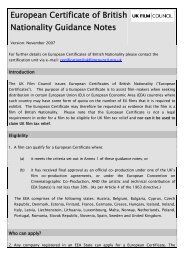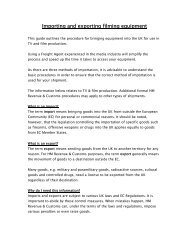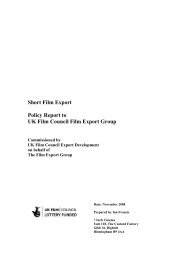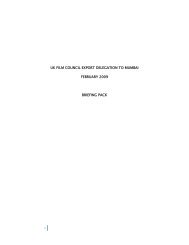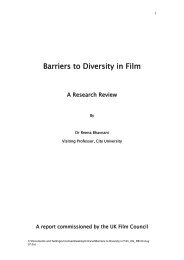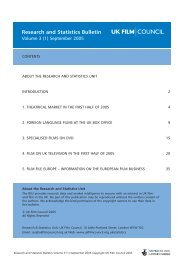Film theft in the UK - Future of Copyright
Film theft in the UK - Future of Copyright
Film theft in the UK - Future of Copyright
You also want an ePaper? Increase the reach of your titles
YUMPU automatically turns print PDFs into web optimized ePapers that Google loves.
lawful use <strong>of</strong> <strong>the</strong> work; and (iii) has no<br />
<strong>in</strong>dependent economic significance. This<br />
exception protects, for example, certa<strong>in</strong><br />
telecommunications providers whose<br />
equipment is used by customers for <strong>in</strong>fr<strong>in</strong>g<strong>in</strong>g<br />
transmissions on <strong>the</strong> Internet. It does not affect<br />
<strong>the</strong> liability <strong>of</strong> <strong>the</strong> user responsible for <strong>the</strong><br />
transmission.<br />
The exist<strong>in</strong>g fair deal<strong>in</strong>g exception for criticism<br />
and review <strong>of</strong> a copyright work (s. 30, CDPA) is<br />
limited by addition <strong>of</strong> a requirement that <strong>the</strong><br />
work has legally been made available to <strong>the</strong><br />
public. The exception for news report<strong>in</strong>g (ibid.)<br />
is tightened by requir<strong>in</strong>g <strong>the</strong> user to give a<br />
sufficient acknowledgment <strong>of</strong> <strong>the</strong> copyright<br />
holder, unless it would “for reasons <strong>of</strong><br />
practicality or o<strong>the</strong>rwise” be impossible to do<br />
so.<br />
The mak<strong>in</strong>g <strong>of</strong> copies by teachers for purposes<br />
<strong>of</strong> <strong>in</strong>struction and exam<strong>in</strong>ation <strong>in</strong> film and<br />
television schools (s. 32, CDPA) rema<strong>in</strong>s<br />
permitted, but a sufficient acknowledgement is<br />
now required, unless this would be impossible<br />
(as above). The exception for <strong>in</strong>struction is now<br />
limited to that carried out for a noncommercial<br />
purpose. Similarly, <strong>the</strong> exception<br />
for copy<strong>in</strong>g <strong>of</strong> broadcasts by or for educational<br />
establishments (s. 35, CDPA) now requires<br />
sufficent acknowledgement <strong>of</strong> <strong>the</strong> broadcast to<br />
be given and limits <strong>the</strong> exception to noncommercial<br />
educational purposes. The revised<br />
section permits electronic transmission <strong>of</strong> such<br />
a copy with<strong>in</strong> <strong>the</strong> school or college concerned,<br />
provid<strong>in</strong>g <strong>the</strong> transmission is limited to <strong>the</strong><br />
premises <strong>of</strong> <strong>the</strong> establishment.<br />
The exist<strong>in</strong>g exception for time-shift<strong>in</strong>g (s. 70,<br />
CDPA) is tightened by a requirement that <strong>the</strong><br />
copy be made “<strong>in</strong> domestic premises”. Such a<br />
copy may not be sold, hired out, <strong>of</strong>fered or<br />
exposed for sale or communicated to <strong>the</strong><br />
public. This means that copies <strong>of</strong> films and<br />
programmes recorded for later view<strong>in</strong>g cannot<br />
be used for o<strong>the</strong>r purposes. Similarly, <strong>the</strong> tak<strong>in</strong>g<br />
<strong>of</strong> a photograph <strong>of</strong> a broadcast work from <strong>the</strong><br />
television screen for private and domestic use<br />
(s. 71, CDPA) rema<strong>in</strong>s excepted from liability,<br />
but <strong>the</strong> photograph must be taken <strong>in</strong> domestic<br />
premises and may not subsequently be dealt<br />
with.<br />
The cable retransmission <strong>of</strong> a wireless<br />
broadcast rema<strong>in</strong>s excepted <strong>in</strong> certa<strong>in</strong><br />
circumstances (s. 73, CDPA). The Regulations<br />
now provide that for <strong>the</strong>se purposes cable<br />
retransmission <strong>in</strong>cludes microwave<br />
transmission between terrestrial fixed po<strong>in</strong>ts.<br />
Currently, designated, not-for-pr<strong>of</strong>it bodies are<br />
permitted to copy broadcasts <strong>in</strong> order to<br />
provide sub-titled or o<strong>the</strong>rwise speciallyadapted<br />
copies to handicapped persons (s. 74,<br />
CDPA). The Regulations make it clear that such<br />
bodies may, <strong>in</strong> addition to rental or transfer,<br />
provide adapted copies by way <strong>of</strong> loan.<br />
Protection <strong>of</strong> technological measures<br />
The CDPA already provide protection for copyprotection<br />
measures (s. 296). With <strong>the</strong> advent<br />
<strong>of</strong> digital media and <strong>the</strong> Internet, such<br />
technical protection is <strong>of</strong> great importance to<br />
<strong>the</strong> video <strong>in</strong>dustry. The Regulations<br />
substantially amend <strong>the</strong> exist<strong>in</strong>g provision,<br />
giv<strong>in</strong>g much enhanced protection for right<br />
holders.<br />
The circumvention <strong>of</strong> an effective technological<br />
measure (a copy- or access-control measure or<br />
a process <strong>of</strong> scrambl<strong>in</strong>g or encryption) applied<br />
to a copyright work is a civil wrong (s. 296ZA,<br />
CDPA). The copyright holder, his exclusive<br />
licensee or a person who issues copies <strong>of</strong> <strong>the</strong><br />
work or communicates it to <strong>the</strong> public with <strong>the</strong><br />
benefit <strong>of</strong> such technological protection may<br />
sue any person who carries out <strong>the</strong><br />
circumvention with reasonable grounds to<br />
know that he is pursu<strong>in</strong>g that objective. Those<br />
carry<strong>in</strong>g out research <strong>in</strong>to cryptography are not<br />
liable, unless <strong>the</strong> rights <strong>of</strong> <strong>the</strong> copyright holder<br />
have been prejudiced.<br />
An <strong>of</strong>fence is committed by anyone carry<strong>in</strong>g<br />
out <strong>the</strong> commercial manufacture or<br />
importation <strong>of</strong> devices primarily designed,<br />
produced or adapted to circumvent<br />
<strong>Film</strong> <strong><strong>the</strong>ft</strong> <strong>in</strong> <strong>the</strong> <strong>UK</strong> | 75






